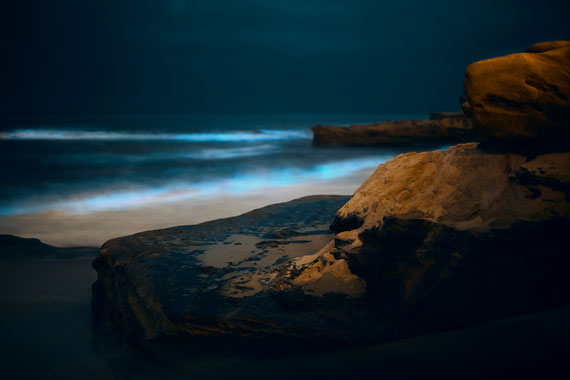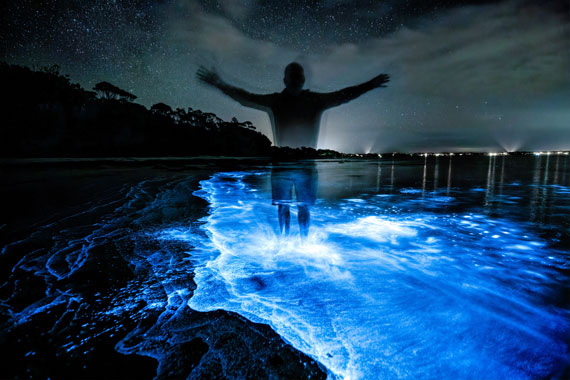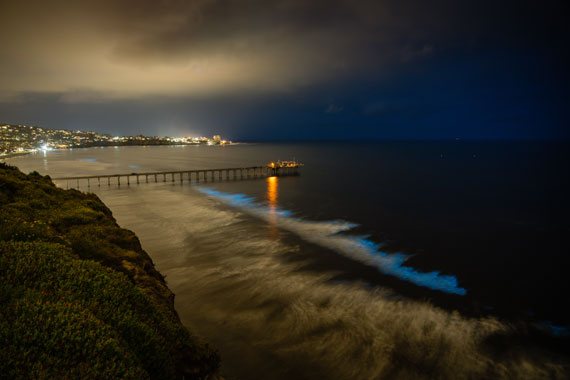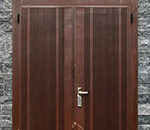Photographers are currently flocking to San Diego to capture this rare phenomenon.
Bioluminescence, the emission of light by living organisms, offers photographers the opportunity to capture some of nature’s most mesmerizing spectacles. From glowing plankton on a beach to fireflies adorning the night, bioluminescence has never failed to leave viewers in awe. But how do you capture such fleeting, dim light phenomena with your camera? Let’s dive in.

Photo captured by Patrick Fore; 50mm, f/1.4, 10 seconds, ISO 400
1. Understand Your Subject
- Planktonic Bioluminescence: Often seen on beaches, this type of bioluminescence is caused by microscopic organisms, like dinoflagellates, that emit light when agitated.
- Fireflies and Lightning Bugs: These insects produce light through a chemical reaction in their abdomen.
- Deep-sea Creatures: Some fish and jellyfish have bioluminescent capabilities, but photographing them requires underwater equipment.
2. Equipment You’ll Need
- A DSLR or Mirrorless Camera: These offer manual settings that allow you to adjust for low-light conditions.
- A Tripod: Essential to stabilize your camera for long exposures.
- Fast Lens: A lens with a large maximum aperture (e.g., f/1.4, f/1.8, or f/2.8) will allow more light into your camera.
- A Remote Shutter or Intervalometer: To avoid camera shake during long exposures.
3. Camera Settings
- ISO: Start with an ISO between 800 and 1600. You might need to increase it in very low-light conditions, but be wary of noise.
- Aperture: Use the widest aperture your lens allows (e.g., f/1.8 or f/2.8) to let in the most light.
- Shutter Speed: Start with 10-30 seconds. Adjust based on the intensity of the bioluminescence and ambient light. Remember, the longer the exposure, the more likely you’ll capture movement (like waves).
- Focus: Autofocus might struggle in the dark. Switch to manual focus and use a flashlight or a distant light source to help set focus, then turn the flashlight off before capturing the image.

Photo captured by Trevor McKinnon; 15mm, f/3.2, 15 seconds, ISO 1250
4. Location & Timing
- Avoid Light Pollution: Head to remote areas away from city lights. Use apps like ‘Dark Sky Finder’ to identify ideal locations.
- Check Tides & Moon Phases: For photographing bioluminescent plankton, a new moon or crescent moon phase is ideal. The lower the ambient light, the better the bioluminescence will stand out.
5. Composition Tips
- Foreground Interest: Add elements like rocks, trees, or people for a sense of scale and to make your composition more engaging.
- Reflections: Capture the glow of the bioluminescence in water reflections for a magical effect.
- Movement: For scenes with waves or moving creatures, play with shutter speed to either freeze motion or capture a silky, ethereal effect.
6. Post-Processing
- Noise Reduction: Use software like Topaz Photo AI, Adobe Lightroom or Photoshop to reduce the noise that can be introduced at high ISOs.
- Enhance Details: Boosting contrast, clarity, and sharpness can bring out more details in the bioluminescence.
- Adjust White Balance: Bioluminescence can sometimes appear too blue or green. Adjust the white balance to get a more natural tone if necessary.

Photo captured by Richard Schneider; 24mm, f/4.0, 8 seconds, ISO 1250
7. Respect the Environment
- Leave No Trace: Ensure you take out everything you brought in.
- Avoid Flash and Bright Lights: Intense lights can disrupt the behavior of bioluminescent organisms and other wildlife.
Conclusion
Photographing bioluminescence is a blend of technical know-how, patience, and a profound respect for nature. With the right gear, settings, and mindset, you’re well on your way to capturing the magical glow of the natural world.
Remember, photography is as much about experimentation as it is about following guidelines. Use this guide as a starting point, and don’t be afraid to play around and discover what works best for your unique situation.
For Further Training:
For help remembering the camera settings for difficult situations like Auroras, a set of Photography Adventure Cheat Sheets are designed to help. They are currently 80% off today if you want to check them out.
The perfect companion for any photographer. Print one out whenever you need it. Whether you’re going on vacation or seeking out a specific photography adventure, these cheat sheets can provide you with the knowledge and inspiration you need to create your best work yet.
Deal ending soon: The Photography Adventure Cheat Sheets at 80% Off
Like This Article?
Don't Miss The Next One!
Join over 100,000 photographers of all experience levels who receive our free photography tips and articles to stay current:







Leave a Reply